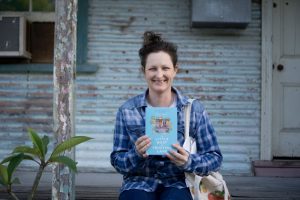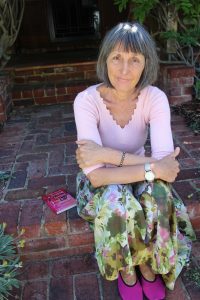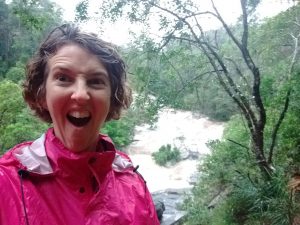It’s always wonderful to hear about authors’ paths to publications, so it is a pleasure to welcome today Karen Herbert, author of The River Mouth to share her story. Over to you, Karen. 
This time two years ago, I was an aged care executive. I didn’t know that soon I would be made redundant and spend the winter writing two novels that would be accepted for publication the following year. Today, as the federal government releases the report of the Royal Commission into Aged Care Quality and Safety, I’ve been reflecting on the last two years and wondering what I can learn from them.
Aged care is rewarding, exhausting and all-consuming. There is never enough money, staff or hours in the day. There are always changes that need to be made to a resident’s care as they age and their health declines. Leaving work issues at work is not an option. Like nurses with patients and school teachers with students, aged care workers go home each night and worry about their residents, about the amount of food they left on their plate, about their last fall, about how long it has been since they had a visit from family. About how they themselves didn’t spend enough time just sitting and talking instead of racing through the daily care plan before moving on to the next resident.
I was in charge of retirement villages and home care when my position was made redundant. Losing my job was like losing an arm. As I packed up my desk and remembered all the things I still needed to do, I scribbled notes about resident care plans that had to be updated, requests for changes to cleaning schedules, invoices to be finalised for the previous month. I drove home remembering resident morning teas scheduled for the following week that I would not be attending and family members who had contacted me for help in navigating the maze of the aged care funding system. I walked in the front door and sobbed the news to my husband, drank a glass of wine, and another, and promised him I would take time off before looking for another job. Aged care, he’d observed, had been taking its toll, and maybe I needed a rest.
The next day, I didn’t register my resume on Seek. Instead, I dressed for work, went to my home office and wrote the first two thousand words of my first novel. The next day I wrote another two thousand words, and the next day another two. I was used to working hard. I kept going until I had a completed manuscript 12 weeks later. Then I wondered what to do next, so I applied for a couple of jobs and wrote another one.
It took a stupid amount of courage to give my work to someone to read. Writing, it seemed, was the easy part. The words flowed. They delighted me. I laughed as I wrote, startling the dogs, and when I had ideas in the shower I hurried back to my desk, dripping water on the carpet. Over dinner, I updated my family on my characters’ progress, and they made suggestions for roadblocks and plot twists. But I didn’t let them read any words on a page. That was too hard, too revealing. It was one thing to talk about my fictional friends over dinner, but what if my writing was rubbish? How embarrassing. Sharing my actual written words didn’t come until I joined a writing group. In the first five minutes of the first session, the facilitator announced that we would have time to read aloud from our work. I was horrified. It was all I could do not to crawl under the table.
I got over it. I read to the group that first time, and then again, and again. I learned to receive feedback and to give it with kindness and encouragement in the same way it was given to me. I relearned my high-school lessons about character, plot and setting, practised showing not telling, and sent my manuscript to beta readers. I edited and re-edited, and was astonished by the way typos, clunky sentences and plot inconsistencies persisted in draft after draft. I worked hard. I dreamed about my characters and woke up to realisations about structural errors. In the final week before Christmas, eight months after I was made redundant, I sent my first manuscript to Fremantle Press. Two months later, they called me. ‘We’d like to publish your book,’ they said.
That phone call was a well-timed ego boost. The first thing I learned from my post-redundancy writing effort was that I am not immune to the loss of status that tests people when they lose their jobs. It hurts. I had nowhere to go each day, nothing useful to do. I lost my position on industry committees. I was out of the loop in speculation about the royal commission. When allegations of abuse in nursing homes hit the media, I had no-one to talk with about the horror of the neglect or the fear that the same thing might be happening under our own watch. I felt shame that I wouldn’t be part of any eventual solution. But that phone call was the first sense that maybe I could do something different. Someone wanted to publish my book; maybe I could do this new thing.
The second thing I learned from post-redundancy life was how to stick with something when there is only me to encourage me along. Corporate life had taught me about perseverance – building a new retirement village or introducing new home care services takes time and patience – but at least in a corporate office you have a team that can pick you up when you are gloomy about being short-staffed or going over your budget. When it’s just me and the dogs at 2.30 pm on a Wednesday and the scene I am writing is rubbish, there’s no-one to suggest I stop for a coffee or work on a different chapter. I have to do that for myself.
The third thing I learned is that a writer writes. Even if what I am writing is rubbish, if I want to finish a manuscript, I have to sit down at my desk and … write. It seems obvious, and very unromantic, but the muse only comes when I am working. It’s much the same as any other job; if you want to make a difference you have to put your shoulder to the wheel and work at it.
I will be part of the aged care solution. I have joined the board of Advocare, a wonderful organisation that helps older people and their families negotiate the system and have a voice in their care. Whatever solution government proposes when it responds to the royal commission report in May, that voice will still be needed as the government makes changes to the aged care system. I am fortunate that I will be able to help make it heard.
I can also use my own voice. I can have older characters, who are not just sweet old ladies, but strong women who once managed households and ran corporations. Maybe they will be a force for good. Maybe they will be the villains in my stories. By the time my first book is released in October 2021, changes in aged care will be well underway. I look forward to being part of the change and a force for good.
The River Mouth is available in all good bookstores and online.
https://www.fremantlepress.com.au/products/the-river-mouth
You can connect with Karen Herbert on
Instagram: https://www.instagram.com/herbert_whittle/
Twitter: https://twitter.com/herbert_whittle
Or on her website: https://karenwhittleherbert.wordpress.com





 Fogarty Literary Award, ‘an engrossing war story and a captivating tale of love and obsesssion’. In this post Michael shares where his inspiration came from.
Fogarty Literary Award, ‘an engrossing war story and a captivating tale of love and obsesssion’. In this post Michael shares where his inspiration came from.







 passionate about, because that’s why I wrote
passionate about, because that’s why I wrote 
 touring authors.
touring authors.
 We are the voices too often unheard, the people too often unseen. But we are here; we are speaking. And through this book, we invite you into our worlds.
We are the voices too often unheard, the people too often unseen. But we are here; we are speaking. And through this book, we invite you into our worlds.